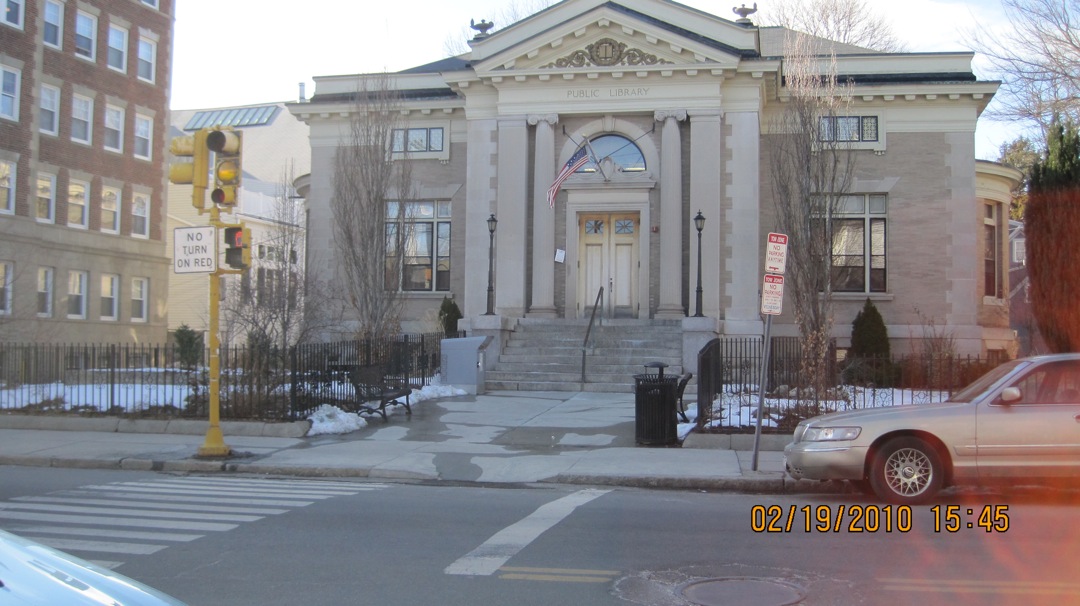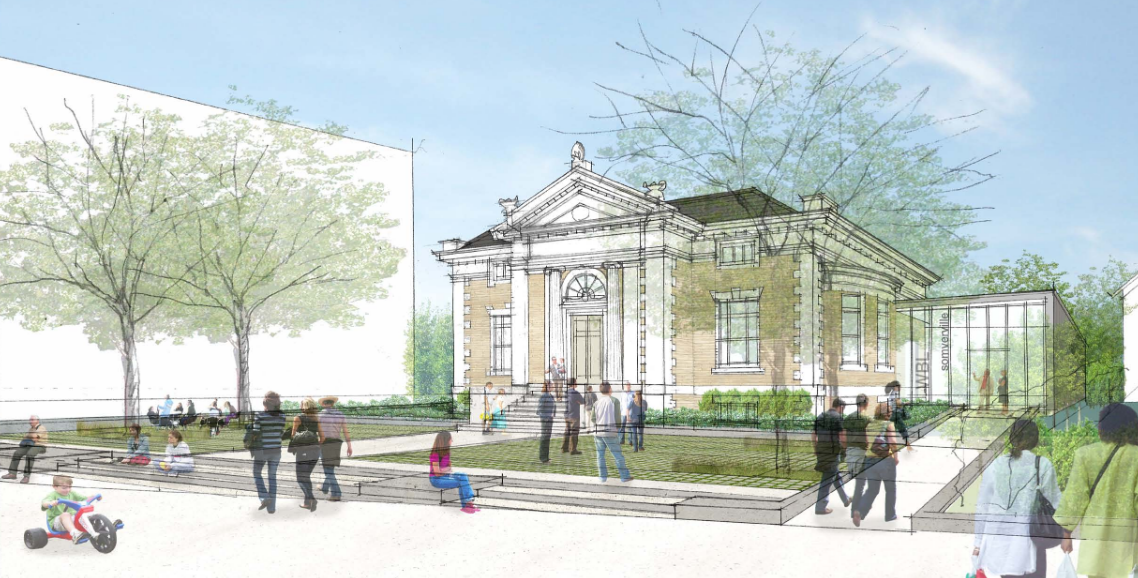callan \ blog
june 5, 2016
Disclaimer: This post does not represent the views of, nor is it in any way endorsed by, my employer. I have done what I can to distance my professional and personal identity/ies on this blog, but realize that the nature of online media makes a perfect separation virtually impossible. All contents are my own thoughts, feelings, and reactions as a private citizen of Somerville who would be impacted by the outcome of the project described below.
On June 1, I went to a community meeting about the proposed renovation/expansion plan for the Somerville Public Library's West Branch in Davis Square. The main goals for the project are to make the building ADA compliant, get the children out of the basement, make the stacks more browsable, and add flexible, programmable space. Wednesday's meeting was the more pragmatic third act in a series of community visioning and planning sessions, this time aiming to address the proposed landscaping and the concerns of the building's direct abutters.
The current building, which opened in 1909, is a classic New England Carnegie - a turn-of-the-century paean to all that libraries were in those days, safe houses where the outside light couldn't warp the paper, where the pages could quietly be turned under supervision. Books were by far and away the medium du jour, though by that point, periodicals and circulating media collections of ephemera like photographs of Europe and faraway lands were making their way into some collections as well. Those books were expensive, and now-commonplace library deals and discounts with publishers were yet to be worked out in the course of the 20th century.

Does anybody else kinda just want to nuke the Carnegies? OK, that's a bit much. But we're running out of things to love about them in 2016.
1909 was around the midpoint of Andrew Carnegie's library generosity spree. Between 1883 and 1929, he funded the construction of over 2,500 libraries around the world. At that time, the notion of a public library was still pretty new, but the role of library as community center was already taking root. The Boston Public Library had a legendary children's room and collection by then. In 1901, a statewide survey in Massachusetts asked librarians and trustees to describe the qualities of good library service:
"A good librarian of today is quite distinct from what would have been called a good librarian of a quarter century or more ago. Such a person must know books…as well as have knowledge of the best methods of caring for the best interests of all connected with the library."
"The librarian should become informed concerning conditions throughout the town, and should study to make the library’s influence reach all parts of it. Especial attention should be given to the needs of children, and there should be no age limit."
"Allow readers as much freedom as possible in the use of the library."
One of the main problems with Carnegies and other turn-of-the-century buildings is that they don't allow for as much freedom as possible in the use of the library. They're not inclusive to all. They have inaccessible entrances, narrow staircases, low ceilings, and poor ventilation. They dump all the walks of life in a community in a handful of crowded rooms, often leading to a children's space crammed into a windowless, moldy basement. ADA regulations require all programming in inaccessible libraries to be made available at city's other branches, which both limits offerings and autonomy at the West Branch and adds an extra barrier to services for people who need accessible entrances and infrastructure.
There's a handful of Carnegies in Massachusetts that have seen significant renovations including the Athol Public Library, which added 16,000 square feet, dedicated children's and teen spaces, meeting and quiet study areas, "laptop bars," and a local history room in 2014. Athol's new building is fully accessible and lays claim to being the only Carnegie expansion to meet platinum LEED certification upon completion. The plan for the West Branch isn't that dissimilar - the building plan also works in community meeting spaces, adaptable spots for laptop and other device use, an elevator and an accessible entryway, and reconceptualized areas for kids and young adults.

We could have us one of these.
(Athol Public Library - photo from Tappe Architects)
Somerville residents have rightly called out the West Branch for its inaccesibility for years. That alone ought to justify this renovation. But while we're at it, should the library be left to languish, attempting to make do with an outdated, out-of-touch service model? Carnegies were great, foundational even, in the early days of American public libraries - who knows if we'd have anything like the system we do today without that kind of philanthropy? But they haven't grown or shifted or reconfigured along with the outside world around them. Like many public projects, these libraries thrived for a time, making do with a generous initial investment, but they've withered from decades of austerity and pressure to do more and more with less and less.
I'm going deep with this because based on what I witnessed at this meeting about the West Branch, there's more than a few folks who think libraries are silent, museum-like spaces - places to be seen and not heard, or maybe more accurately to be seen and not used. There are people who think librarians are dishonoring their legacy by embracing the identity shifts and new media and equipment and forms of information that have emerged in the past few decades. There are people who think programmable spaces - god forbid anyone ever label them "makerspaces," even if it's shorthand for something much more inclusive and flexible than that - have no place among the silent stacks. There are people who think putting more computers and outlets in this library is akin to sticking "a mini Apple Store" inside a historic building.

The proposed expansion and re-landscaping. (See the complete project presentation.)
There are people who question librarians' judgment of where libraries are headed these days, of the innovation and community-driven inspiration they want to replicate in their own neighborhoods. They look at proud examples of social workers, safe places for learning when cities like Ferguson and Baltimore had to close schools, creative refuges, after-hours concerts and free meeting space - and they tell librarians to resume "preserving history" and stop "following trends." (Granted, the same folks also questioned the judgment and expertise of the architects, landscapers, and owner's project managers, criticizing their plan sketches, accusing them of falsifying statistics, and regarding them with condescending dismissal for the better part of the 2.5 hours I stuck around for.)
Much of the concern about the West Branch project revolved around the green space that would be lost in Davis Square - justifiably so, given how very little of it there is to be found. To make the building accessible, it's hard to get around that. But running beneath the concern for trees (including a Norway maple - my forestry friends from SUNY-ESF would be shocked to hear anybody getting misty-eyed over one of those, but let's not go there right now), there was something darker, something a few of the loudest voices in the room didn't shy away from sharing: fear of the riffraff. The homeless, the drug addicts, the "people having sex," as one woman put it. Not everyone went exactly there; a few also wondered what they would get out of the redesigned building, especially since their grown-up children had missed out on it. A remarkable lack of empathy was on display all night, not to mention the two guys next to me who teetered on the verge of a fistfight - one of them didn't much care for the other grumbling under his breath during another attendee's comments - and the alderman having to tell the room to "just stop it" and calm down within the first two minutes of the architects' presentation.
It's safe to say the people who need this library the most were not at this meeting. There's serious income inequality throughout Massachusetts, particularly in the Greater Boston area, and that doesn't exclude Somerville. There's a digital divide impacting the entire country that we're not exempt from here. In 2010, over a fifth of the population in the Commonwealth spoke a first language other than English. Many libraries offer free computer and Internet use, free English and citizenship classes, free adult literacy programs, free multilingual storytimes, free high school equivalency study groups - the list goes on. In most communities, the library is the only place to do so (at least without a pricetag). Sure, certain residents of Davis Square may not be able to see how there's a need for these things for the people who live and work in Somerville; they may not see the value and opportunity and equity of access a functional, flexible library would give to our city in 2016. It makes sense; they're not embedded in the community, after all. But librarians are.
If this amounts to following trends, libraries have been following them for at least 115 years. So, when librarians talk about the trajectory of the profession and meeting the needs of the people they're working with day after day, maybe, just maybe, sometime between the era of the Carnegies and today, they should've earned the benefit of the doubt.
home | top
Hey Cal, why is there no comments section? Comments sections have a tendency to devolve into nasty little spaces, teeming with spam & ad hominem attacks. I also have a fondness for the 1.0 Web (props to Neocities, powerer of this site). If you'd like to share your thoughts, find me on Twitter or fire off an email. Thanks!